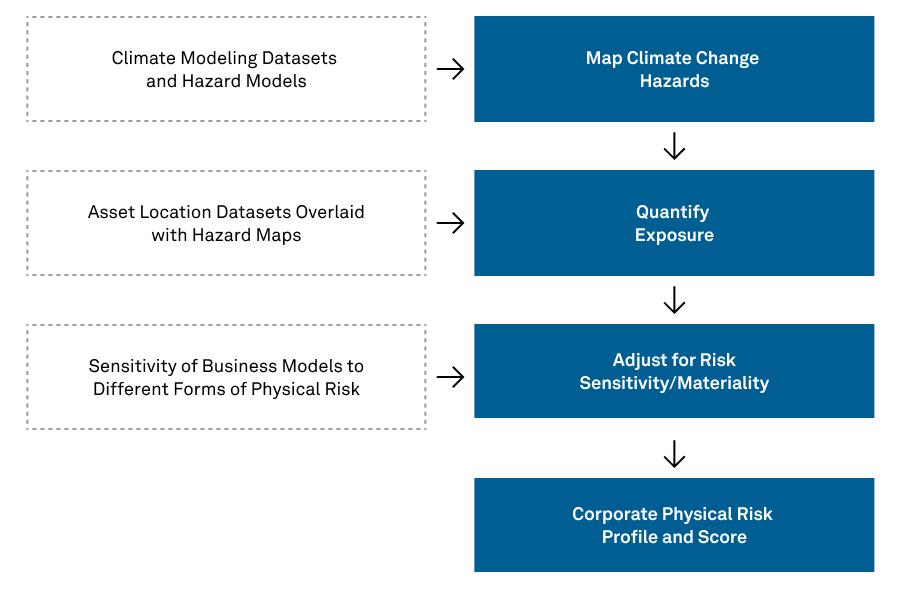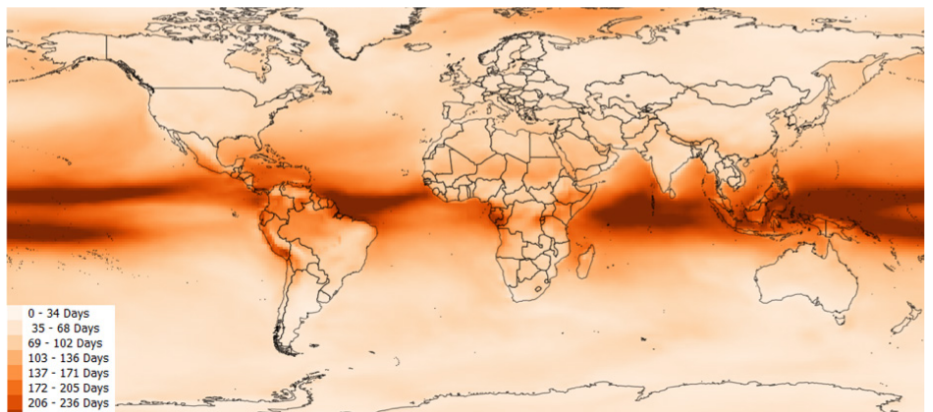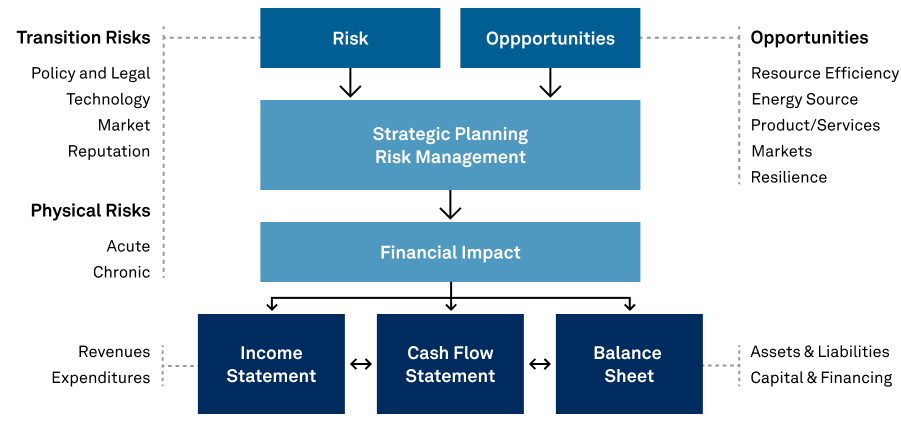This is the second blog in the series on index innovation for net zero. The first blog, Journey to Net Zero with the S&P PACT™ Indices, discusses how a combination of groundbreaking new datasets and index innovation is emerging. We now turn to the use of physical risk data.
Whether you’re located on the Western seaboard of the U.S. or in the flood plains of Bangladesh, chances are you’ve witnessed an alarming increase in the number of extreme weather events in recent years. Indeed, the past 20 years saw a 74% worldwide increase in the number of disasters linked to natural hazards compared to the prior two decades. This has resulted in 1.23 million lives claimed, 4 billion people affected, and $2.7 trillion U.S. in global economic losses, according to the UN.1 The link between such cataclysms and rising global temperatures due to human activity is widely established.2 Yet to date, the majority of climate-related financial models for capital allocation decisions have focused principally on the transition-related risks of decarbonizing the economy, rather than these more tangible and equally costly physical climate impacts. For years, the unpredictability of climate patterns, coupled with only rough estimates of asset locations, made company and investor portfolio-level assessments of physical climate risks guesswork. That is, until now.
Technological advances are paving the way for granular assessments of physical risk exposure built upon climate scenario models, asset-level data, and geolocation specificity of assets with precision. The need to address both types of climate risk3 (i.e., physical and transition), as well as the opportunities associated with climate change, is key to building resilient portfolios, as per the recommendations of the Task Force on Climate-related Financial Disclosures (TCFD) (See Exhibit 1). This is important, as transition and physical risks are not a priori connected. The failure to transition to a low-carbon economy increases the likelihood and severity of physical risks by failing to adapt to climate change, while the failure to mitigate physical risks suggests that the market is not transitioning, thus exposing more sensitivity to the rising occurrence of climate-related hazards.4
Exhibit 1: The TCFD’s Approach to Climate-related Risks, Opportunities and Financial Impacts

Source: TCFD Final Report (2017). For illustrative purposes only.
Unlike transition risks, which could affect companies anywhere, certain locations are more exposed to physical risks (e.g., Miami FL condos and hurricanes). Climate hazard models must therefore be coupled with location-specific, asset-level data. With S&P’s extensive data on 2.8 million asset locations5 and expertise in mapping corporate ownership structures to parent entities, Trucost’s physical risk analytics are unparalleled in this regard. The model essentially maps these granular bottom-up exposures to forward looking and science-based climate scenarios – over the short, medium, and long term – across seven climate hazards. This includes: floods, water stress, heatwaves, coldwaves, hurricanes, sea level rise and wildfires (See Exhibits 2 and 3). A company’s sensitivity to these risks is also determined based on company-level characteristics, such as water intensity, labour intensity and capital intensity. The result is a rigorous and powerful tool to assess company and portfolio-level physical climate risk exposure for more than 15,000 companies.6
Exhibit 2: Example Frequency of Heatwaves Under a High Climate Change Scenario

Source: S&P Global Trucost. For illustrative purposes only.
Exhibit 3: Trucost Physical Risk Methodology Schematic

Source: S&P Global Trucost. For illustrative purposes only.
The potential applications for investors are considerable. By combining the Physical Risk Dataset with Trucost’s Paris Alignment Dataset, for example, investors can help build defenses against all manner of climate-related risks, whatever the outcome regarding our transition to a low-carbon economy. Indeed, S&P DJI’s S&P Paris-Aligned & Climate Transition (PACT) Indices help investors do just that. The methodology incorporates both datasets, while simultaneously addressing myriad other climate objectives. At the constituent level, the index dynamically caps individual company exposure to guard against acute climate hazards (e.g., storms and floods). At the index-level, it reduces the weighted-average physical risk exposure of the index overall, as this helps mitigate the long-term effects of more chronic physical impacts (e.g., sea level risk).
Together, these two datasets signify a scientific turning point in our race against climate change. Investors now have tools to align with a scenario that may mitigate the most catastrophic impacts, build portfolio resilience and, ultimately, achieve our goal of obtaining net zero emissions by 2050.
The next blog in the series, A Declaration of Importance: Climate Risk Is Real, but Paris Alignment Data Can Help Us Solve It, considers new datasets and index innovations that are catalyzing an investor-led revolution to reorient capital flows towards a net zero emissions trajectory by 2050.
1Human Costs of Disasters: An overview of the last 20 years”, UN Office for Disaster Risk Reduction, www.undrr.org/media/48008/download.
2On the Causal Structure between CO2 and Global Temperature”, A. Stips et al, 2016, https://www.nature.com/articles/srep21691
3There are two types of climate risk: transition and physical risks. The latter refers to either: i) acute physical hazards, such as more frequent and extreme weather events (storms, hurricanes, floods, etc.), or ii) the chronic and longer-term effects of climate change, such as changing weather patterns or sea level rise. Transition risks, on the other hand, refer to the costs associated with the policy, legal, technological, market and reputational risks from adapting to climate change and transitioning to a low-carbon economy. Thus, transition risk results in expenses, such as those related to the early retirement of assets, while physical climate risk may threaten disruptions in supply chains and amount to costly insurance premiums, for example.
4For more information about the interplay of transition and physical climate risks, please refer to this report: www.spglobal.com/marketintelligence/en/documents/sp-trucost-interplay-of-transition-and-physical-risk-report-05a.pdf
5As of July 2020
6For more information, please refer to the methodology: www.marketplace.spglobal.com/en/datasets/trucost-physical-risk-(148).
Learn more about how "The Quality Imperative" differentiates our essential sustainability intelligence.
READ MORE >-
Discover multiple layers of ESG insight.
Learn more -
Get comprehensive company analytics and best practice reporting solutions.
Learn more -
Optimize the climate, ESG and impact performance of your investment portfolio.
Learn more
We’re here to help you accelerate your sustainability journey. Get connected with an ESG specialist who can advise you on your next steps.
Talk To An Expert


